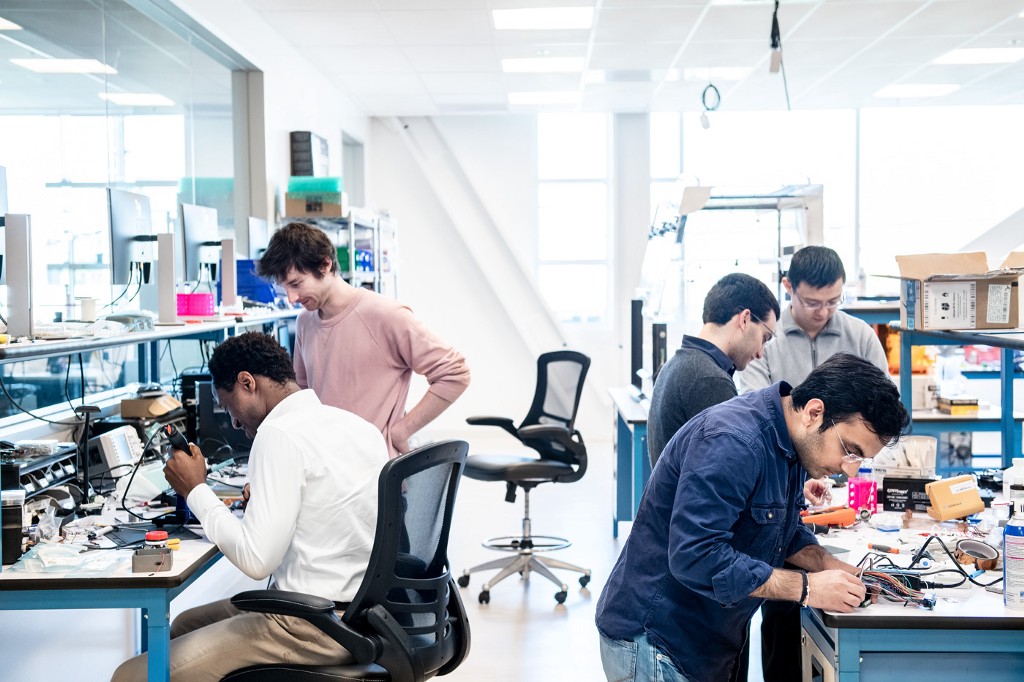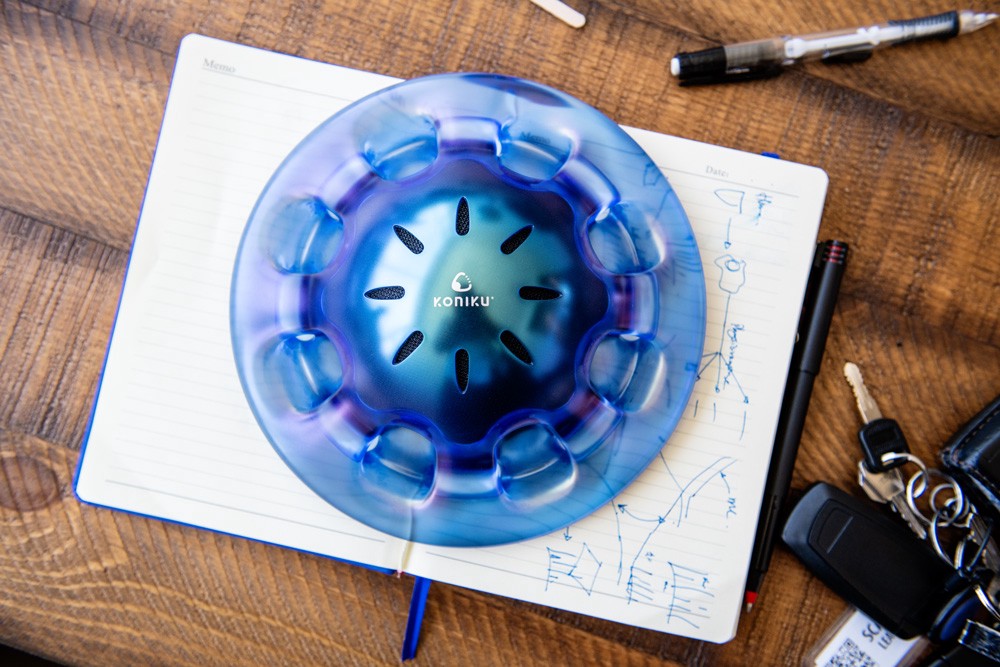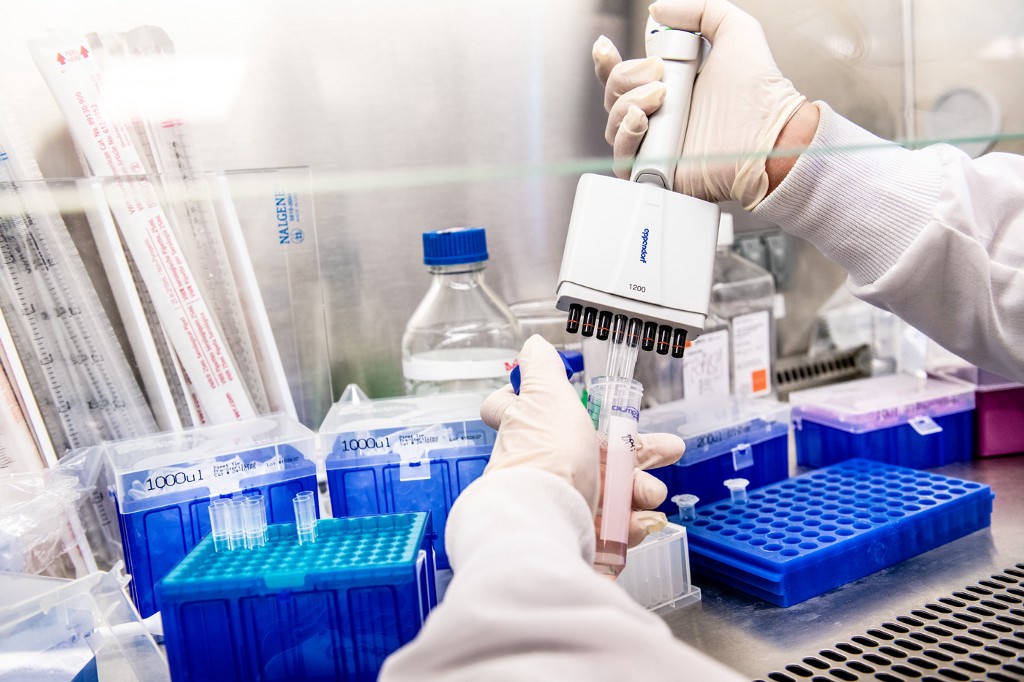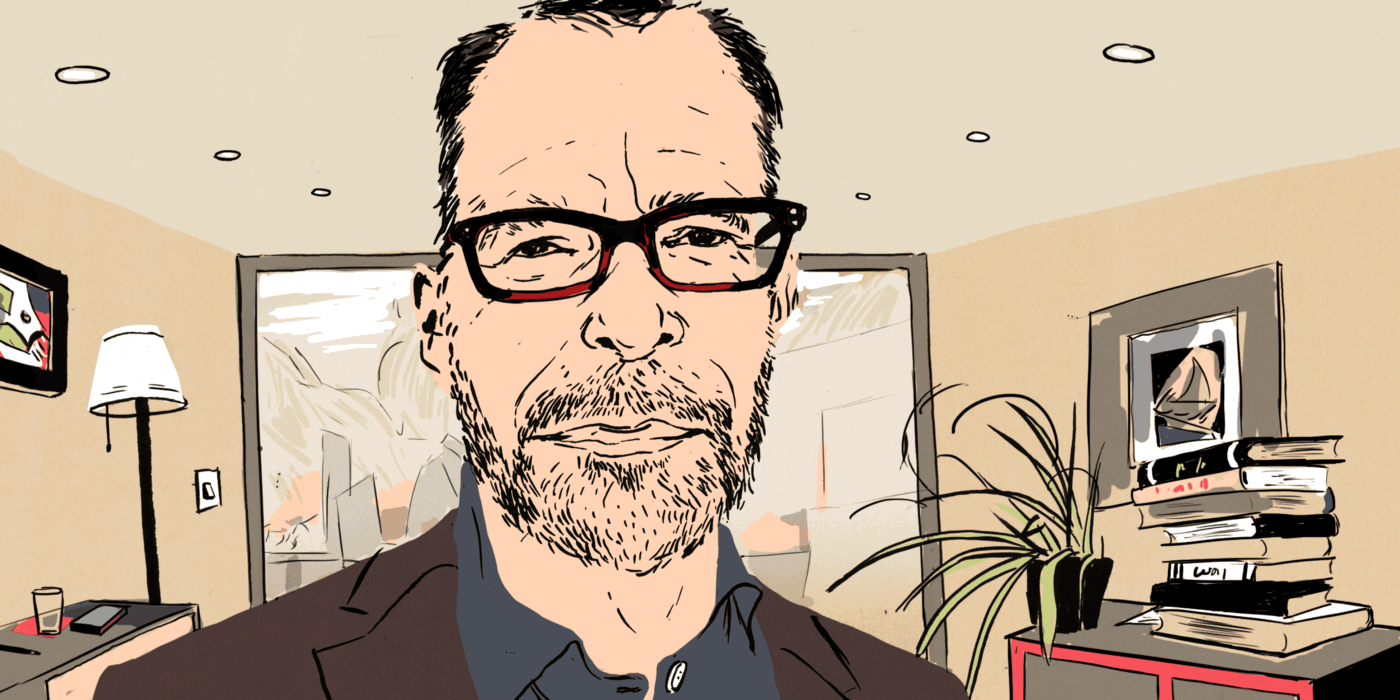Forget what you may have heard about neural networks in software. This startup is making a computer with living neurons.
It’s an odd thing for someone to say about neurons: “Let’s see if anyone is awake.” And it’s an even odder thing to hear in a cavernous, half-furnished office suite where one whole room is occupied only by copy machines and a lonely foosball table.
Not far from that foosball table, Oshiorenoya Agabi and Benjamin Sadrian are sitting in a lab at their startup, Koniku, in Berkeley, California. Agabi founded the company, and Sadrian is a senior neuroscientist. They are toggling between a microscope and a screen full of blue graphs, looking for signs of activity in a cluster of neurons. Sadrian pauses as he scrolls through slightly fuzzy readouts on the screen, reminiscent of stock charts with buzz cuts. “I wish you’d come later, even tomorrow,” he sighs.
These readouts measure signals inside cells, and Agabi and Sadrian are looking for spikes that would show Koniku’s neurons reacting to a chemical Sadrian exposed them to moments ago. When we examined them under the microscope, they glowed a faint neon green, which indicates they’re starting to mature. A few tentative dendrites reached out into the void, the neurons just beginning to form connections with one another. But the telltale spikes don’t materialize on the screen. At just six days old, these neurons are still too young to do the jobs they’ve been engineered to do.
Agabi and Sadrian aren’t just babysitting neurons out of curiosity. Nor are they out to build some biological system for study or observation, as their colleagues up the hill at UC Berkeley might. They’re trying to use these neurons to create computers unlike any that have existed before.
They’ll eventually connect these neurons not just to each other but to silicon chips. At first those chips are being used in devices that sense airborne chemicals. Other possible applications await the technology in industries from drug development to agriculture. A successful brain-machine connection could also someday help us study and treat neurological diseases. And Agabi is very open about his grandest ambition of all, to create a wetware artificial intelligence.
Wetware, a gurgly word with a science-fiction definition, refers to the combination of biology and machine, performing a task that neither can do alone. And this may well be the most ambitious wetware company in the world. Koniku comes from a Nigerian word that means “immortal.”
Since we still don’t know exactly how neurons work together, why try to mimic them?
After Agabi and Sadrian show me their still-maturing neurons, we spend the next hour touring Koniku’s lab, making stops in a “dry” room for working with silicon, which is connected by a custom-built window to a “wet” room for working with cells. We peer into liquid nitrogen storage where, I’m told, some 18 million neurons are incubating. Later, Agabi and Sadrian happily show off their high-powered laser, which they call the “Death Star,” used for manipulating complicated neuron networks on an incredibly precise level. At the moment, it’s being operated by Renaud Renault, who, along with holding the intriguing title of chief unlisted project architect, is known around the office for creating a 200-micron-high image of Big Ben when he was in college.
A neuron-silicon hybrid chip is certainly an elegant idea. Nature spent billions of years evolving neurons for the unparalleled efficiency and flexibility that allows us to sense, analyze, remember, and infer using a tiny fraction of the energy computers require. Since we still don’t know exactly how neurons work together, why try to mimic their processes with “neural networks” in silicon? Why not just use actual neurons in computers?

But nothing is ever that simple. Neurons are optimized to work in the brain but not necessarily to be computers in the way we might like them to be. They’re notoriously finicky to grow and even more difficult to keep alive. And anyone trying to develop and sell this kind of wetware has to answer all kinds of strange new questions: How do you reliably interpret the electrical signals that neurons generate? How do you encode neurons to follow certain rules and test that the cells are behaving accordingly? How do you design a supply chain for technology that is alive?
Although academic researchers have been hooking neurons up to computers for decades, Koniku appears to be the first private company to market a product using this kind of technology. Agabi is thus perhaps understandably cagey about revealing the nitty-gritty details that would show skeptics that his science is sound. But if he is right, he’s closer than anyone else to designing a novel method of computing that blurs the line between biology and electronics. If he’s right, then a peek into this lab is a peek into the future.
The coolest stuff
Agabi, who goes by “Osh,” is tall and slim, with a spiky haircut that matches his neuron readouts, and a light mustache and goatee. He likes fashionable, form-fitting sweaters; speaks with verve, volume, and enormous enthusiasm; and swears prodigiously.
His background isn’t that of your typical startup founder. The 37-year-old grew up the second of seven children in Lagos, Nigeria, roaming a garbage dump near his house to find junk he could tinker with. His mother, whom he calls the “best entrepreneur I know,” runs a general store but never learned to read; his father worked long hours at the local port. Both of them emphasized the importance of education above all else, a focus that eventually compelled Agabi to leave Nigeria to seek a new professional and personal adventure.
His first stop was Switzerland in 2002, where he worked for a robotics company, Neuronics, building neural networks in software for a robot arm. “One of the things that became clear to me was that this system was really, really primitive,” incredibly simple when compared to real arms and brains, he says. So after a year at Neuronics, he left for Sweden to complete a master’s degree in theoretical physics, with an eye toward using math to explain biology. There, he worked on a project that interfaced neurons with silicon. But that work mainly revealed to him that there were gaping holes in institutional knowledge surrounding the mechanics of cellular biology. At one point, he asked a professor: has anyone ever modeled a cell and figured out all of its processes? “I remember her laughing,” he says, “like, ‘This guy is super naïve; nobody can do that.’”
“Maybe we’ll be able to put 10 billion neurons on a chip. They might even be able to hold a conversation.”
His physics studies planted the seed that would become Koniku, instilling in him the conviction that, given the inherent complexities of all living organisms, the best route to artificial intelligence would be to build it with biology. He believes that cognition is an inherent, emergent property that will inevitably result when a complex-enough network of neurons fire together to make sense of the surrounding world. The density and energy efficiency of biological systems is impossible to match, he argues, and its computation potential far outstrips the limitations of silicon. That’s where he got the title for his 2016 TEDx Talk: “Biology is Technology.” Everything else, he says, is “a simulation.”
Agabi tried unsuccessfully to found Koniku in the United Kingdom first, finally finding funding and support in the U.S. through the IndieBio startup accelerator. There, his unconventional ideas were welcomed. “That’s why for me, coming to the Bay Area was like coming home,” he says. “It was like that kid who could go the dump and build cool stuff could now build the coolest stuff.”

The first product Koniku is developing uses its neuron-silicon hybrid chip — which the company calls the Koniku Kore — to “smell” or otherwise sense the presence of a given compound. Early reports indicated Koniku had signed contracts with the pharmaceutical company AstraZeneca, presumably to build a system for testing potential new drugs. But although Agabi won’t say much about his clients, he will say that Koniku is “not actively pursuing” drug development work. The customers that have agreed to buy the startup’s sensors are mostly interested in defense applications, he says. Koniku also recently signed on with a consumer products company to design a system that would use the neurons in the Koniku Kore as taste testers, which could eventually render expensive focus groups unnecessary. Agabi envisions future applications for testing soap or other hygiene products as well.
By creating individual technologies that perform some sensing task, such as tasting, feeling heat, or even seeing, Agabi hopes to lay the groundwork for his ultimate goal of a wetware AI. That stepwise progression also fits with his financing model. Including an initial seed round of $250,000 from IndieBio, Koniku raised a total of $1.4 million in 2016. Then, Agabi heeded the advice of his most trusted business advisor — his mother. Rather than raising more more outside capital, he decided to make do with revenue from customers who are paying to have devices developed and to get early prototypes. He says Koniku had $8 million in revenue last year and is on track to quadruple that number in 2018.
Pink juice
Koniku’s chemical sensor is still in development, so what Agabi and Sadrian show me is likely to continue evolving for some time. On the outside, it sports a globular, gray-green shell with a vaguely alien look, about eight inches wide. Inside, metal architecture supports a silicon chip with spidery wires converging in the center, where networked neurons sit inside a clear bubble made of a biocompatible polymer.
When a client tells Koniku what substance it wants to sense, the company identifies cellular receptors that would ordinarily bind to that substance. Then it creates neurons that have those receptors. To do that, it uses gene-editing technology to tweak the DNA of neuron precursors. Koniku obtains those from a supplier, which manipulates skin or blood cells from mice into blank-slate cells known as induced pluripotent stem cells.

Once Koniku has nurtured these engineered precursors into living neurons, they could, in theory, smell odors like a drug-sniffing dog might. Or they could detect any number of substances that have corresponding receptors. Some receptors are more sensitive and narrowly tuned to attach to one substance. Others are, as Agabi puts it, more “promiscuous,” accepting an entire class of chemicals, like nitrates. The Koniku Kore contains neurons with both types of receptors.
After they’ve created their mix of customized neurons, Agabi and his colleagues use the Death Star laser to build a polymer structure for the neurons to sit on. Then they place the cells on that structure and wait for them to begin to network together among a set of mushroom-shaped electrodes. Ultimately, a few “reporter” neurons will serve as the essential neuron-silicon connection. This means they are both connected to the neuron network and “plugged in” to the chip using the natural process of endocytosis, in which a cell gradually engulfs foreign matter. Agabi says Koniku has developed a special DNA coating for its electrodes. When a neuron tries to engulf the DNA, it creates a seal that will later let the electrode pick up electrical signals the neuron produces when its receptors bind to a given chemical or class of chemicals.
Almost all of this technology was around before Koniku, though not exactly in this arrangement. Perhaps the newest element here is what Agabi calls “pink juice.” The usual life span of a neuron in a lab is counted in days or weeks, but Koniku’s neurons can survive for up to two months. That’s because they’re bathed in pink juice, which feeds them and keeps them alive.
At first, Agabi won’t tell me the exact recipe beyond saying that they’re a mix of “vitamins, minerals, and sugars.” But I piece some of it together by talking to Thomas DeMarse, a neuroscientist at the University of North Carolina.
Biology is technology, Agabi says. Everything else is a simulation.
DeMarse spent time in the spotlight in the early 2000s for his research teaching rat neurons in a dish to fly a virtual plane by connecting them to flight simulator software. He also did groundbreaking research on neuron survival. He points out that there are a number of similar “juices” already on the market, with names like BrainPhys and Neurobasal. Those pink juices get their color from a substance called phenol red, which indicates the liquid’s pH level. They also contain a carbonate buffer that helps maintain acidity and simulates conditions in the brain. Using similar materials, DeMarse was able to keep neurons alive on a desk for two years. They would have lived longer, he says, but during that time he moved from Caltech to Georgia Tech, and the plates started to leak en route.
Later, when I ask Agabi if he’ll at least tell me whether his pink juice contains phenol red and a carbonate buffer, he confirms the first and denies the second. Academic groups may have needed the carbonate buffer to simulate the brain, but unlike those neuroscience labs, Koniku is unconcerned with mimicking the brain, Agabi says. “The power of the neuron comes from the computational density — as long as we maintain that, we can change everything else.”
With the help of Koniku’s pink juice and a new automated pump system that will be incorporated into each sensor, Agabi expects to eventually reach DeMarse’s record for neuron longevity. Even then, his customers would have to swap out their Koniku equipment every two years, but no one has requested products with greater neuron longevity — and therefore, Agabi says, it has not been a development priority. With the technology at hand, he says, he could develop a Koniku Kore that would last five years, were a customer to require it.
Improving on evolution
“To me the devil is in the details here,” says DeMarse. What he means is: before Koniku, its kind of wetware lived in academic and government labs. In addition to DeMarse’s research, scientists at DARPA have worked for a long time on an artificial nose to detect cancer. William Ditto, now of the Nonlinear Artificial Intelligence Lab at North Carolina State University, used leech neurons in a dish to carry out basic computations. Although no one has done exactly what Koniku says it’s doing, there’s plenty to back up the argument that someone could do it. In fact, DeMarse says he was “tickled” to read about Koniku’s innovations. Gabriel A. Silva, director of the Center for Engineered Natural Intelligence at the University of California, San Diego, is also intrigued by Koniku’s potential. “I never underestimate groups like this because they’re trailblazers,” he says.
Still, Agabi’s colleagues in the academic world maintain some skepticism about whether his technology can live up to his grand ambitions and radical vision for the future of machine intelligence.
For one thing, neurons have evolutionary baggage that might be unnecessary for a computer. As an example, Rajesh Rao, director of the Center for Neural Engineering at the University of Washington, points to myelin, the fatty sheath that insulates nerve fibers and helps signals propagate in the brain. It’s not clear, Rao says, that the optimal computer would have to mimic that method of communication. Or consider dendrites, the branches that stretch out from the body of a neuron. Neuroscientists aren’t sure whether dendrites actually participate in information processing or are just wires that pass information from cell to cell. Does moving information in a computer really demand some version of dendrites?
With issues like this in mind, all the scientists I spoke with for this article said that while looking to biology for inspiration will be essential for the development of AI, they were not entirely convinced by Agabi’s argument that it will require biology itself. Just as planes use the same principles of lift as birds do without feathers or hollow bones, “we can extract the computational principles of how the brain processes information” and use them in a manner “independent of actual implementation in biological tissue,” Rao says.
For example, neuromorphic chips are silicon chips designed using biological principles, attempting to mimic some ways that the brain processes information while leaving some of its baggage behind. Ditto, the researcher who once made a computer out of leech neurons, is now working on a “chaotic chip,” which constantly changes from analog to digital processing — as often as a billion times a second — in order to solve problems more efficiently. He argues that AI will require the plasticity and adaptive capacity of biology, but that the biological element is optional.
After all, coaxing neurons in a dish into computation isn’t so easy, either. Even making sure they grow successfully is difficult; Silva remembers struggling during graduate school with neurons that had suddenly stopped growing, seemingly for no reason. “It turned out that the manufacturer of the coverslips we used had changed the formulation of the glass,” he says. “That alone was enough to make the neurons unhappy.” Even when they do grow, a group of neurons, however well networked and organized, do not automatically make a brain. The distance from chemical sensing to cognition is awfully long, and the slippery nature of even the idea of cognition complicates this question. A basic system that uses reward or punishment to teach things to computers “is going to give you some behavior that will look intelligent,” Rao says. But isn’t there more to cognition than that, more ingredients and sensory inputs that help us react to, interact with, and make sense of the world? The wetware recipe for that is far from clear.
“I never underestimate groups like this because they’re trailblazers.”
There are also ethical concerns, even this early on, about whether a neuron-silicon hybrid could become too smart and somehow go rogue. Ditto has stopped neuron-based research because of these worries: “That’s how much I believe it could work.” He feels strongly that there ought to be a kill switch built into any kind of wetware, even in the beginning stages, as the simplest form of constraint and control. “We want to think about that now,” he says, “before anything we have wakes up.”
When I bring all these questions to Agabi, he seems genuinely thrilled, his answers tumbling out of him faster and louder the more excited he gets. Still, he doesn’t give much credence to his skeptics. In response to the argument that biology makes for good inspiration but not necessarily a good material for computing, he returns to his “biology is technology” mantra. He’s convinced that building with biological elements is the only way to reach and then surpass the capabilities of the real thing.
He also brushes off Rao’s concerns about the evolutionary baggage in neurons, arguing that the same innovations in gene editing that allow Koniku to create neurons with custom receptors can help him take what nature has given and turn it into wetware that is better. “Evolution is non-directed; it dicks around a lot,” he says, smiling. “But when we have it in our heads, we can direct it, and that’s more powerful. We know exactly what we want to delete. We want to build a brain; we don’t want to build the brain. There’s a massive difference.”
As for a kill switch, there’s already one built into the Koniku Kore’s design, although Agabi won’t elaborate on how. His customers required it.
Taking out the humans
Long before Agabi can begin tackling the design of a true wetware-based intelligence, he’ll face a more prosaic challenge, one that confronts most hardware companies: how do you scale up?
There’s no existing chip manufacturing process that incorporates live cells, so one would have to be created — bringing up a novel constellation of logistical questions, such as when in the shipping process a device that is alive should “wake up” and be ready to function. And as Rao points out, we still don’t understand the learning dynamics of neural networks, especially using real neurons. “They might learn decision-making skills that aren’t easy to understand,” he says. “There isn’t an easy way to validate that the way you would with a chip.” That might require a whole new generation of testing and verification software.
One hallmark of any reliably scalable product — automated manufacturing — would seem to be impossible with a product that requires so much exacting care. But Agabi believes the problem of neuron delicacy and the problem of scalability can be solved the same way. “Seventy percent of the problems you come across [in working with neurons] are because of human handling,” he says. “This is why we want to take the humans out of it.” In the last six months alone, he says, Koniku has invested more than $1 million in systems like one he shows me on our tour. In a small windowless alcove an apparatus rears neurons, monitoring their health and growth. The place is filled with complicated machinery, a low, pervasive hum — and no humans.
Automation aside, delivering Koniku customers their “smelling” sensors and beginning work on its Koniku Kore-based taste tester constitute most of the company’s current work. The company also plans to release a neuron-silicon hybrid developer chip for a select few tinkerers to play with by the end of the year. Beyond that yawns the chasm between neurons-as-material and neurons-as-intelligence.
With the real possibilities of smelling and tasting machines in the offing, even skeptics like Rao can’t help but daydream about possible applications for Koniku’s technology: machines that help injured brains repair themselves, perhaps, or that monitor disease, helping us understand the mechanics of Alzheimer’s. Ethical concerns and logistical tangles aside, it would seem a wetware market is coming.
A human brain has about 86 billion neurons. The test chip Agabi and Sadrian showed me hosted 200,000 neurons arranged around 120 electrodes. The most neurons Koniku has successfully networked is about two million, but Agabi expects that number, like the neurons themselves, to continue to grow. “Eight years from now, maybe we’ll be able to put 10 billion neurons on a chip; they might even be able to hold a conversation,” he predicts.
Really? In eight years?
He grins. “I think if any company is gonna do it, it’s us.”
















